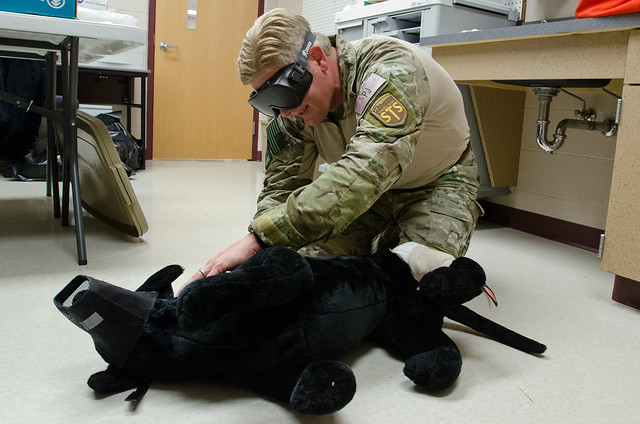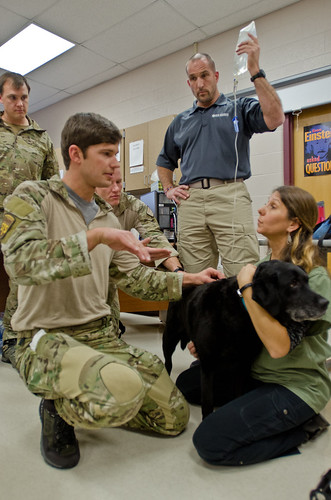Story by Master Sgt. Phil Speck, 123rd Airlift Wing Public Affairs
[caption id="" align="aligncenter" width="576"]

Senior Master Sergeant Billy Hardin, pararescue superintendent for the Kentucky Air National Guard’s 123rd Special Tactics Squadron, practices providing medical care to a simulated military working dog while blindfolded to simulate darkness during a training session at Jefferson Community College in Shelbyville, Ky., on Dec. 5, 2013. Hardin is one of 10 Kentucky Air Guard pararescuemen who learned to treat military working dogs during the two-day course. (U.S. Air National Guard photo by Master Sgt. Phil Speck)
SHELBYVILLE, Ky. -- Pararescuemen are the Air Force’s jump-qualified trauma specialists. They provide injured troops with emergency medical care in the most austere combat environments.
But what happens when the patient is a dog?
On a recent deployment to an overseas combat theater, one pararescuemen from the Kentucky Air National Guard’s 123rd Special Tactics Squadron treated twice as many dogs as people.
“There has been a huge rise in the use of dogs on the battlefield, and unfortunately they are getting injured because they are sometimes the first to engage the enemy,” said Senior Master Sergeant Billy Hardin, pararescue superintendent for the 123rd.
[caption id="" align="alignleft" width="232"]

Staff Sgt. David Covel (left), a pararescueman from the Kentucky Air National Guard’s 123rd Special Tactics Squadron, helps administer an intravenous solution to a dog with the help of Thomas Barrett, a civilian paramedic and K9 medic trainer, and Kalee Pasek, a doctor of veterinary medicine and education coordinator for K9 medics at Jefferson Community College in Shelbyville, Ky., Dec. 5, 2013, as part of a two-day training course. Covel is one of 10 Kentucky Air Guard pararescuemen who learned to treat military working dogs during the course. (U.S. Air National Guard photo by Master Sgt. Phil Speck)
In an effort to enhance their combat veterinary skills, 10 of the unit’s pararescuemen recently completed a two-day training course at Jefferson Community College in Shelbyville, Ky., taught by K9 Medic, a private firm that specializes in medical education for the emergency care of dogs.
Prior to attending the course, the pararescuemen’s only veterinary training was gleaned through personal battlefield experience and by working informally with military dog handlers and civilian veterinarians.
According to Hardin, canines can be a bit more challenging to work with than people.
“The first thing you want to do is muzzle the animal, so you don’t get bit,” he said, explaining that dogs don’t understand you’re trying to help them.
Communications is another problem.
“People can tell you what hurts, but dogs don’t,” he said. “They just kind of look around. So you have pay close attention to them and their movements.”
Injuries on military working dogs, which perform missions like explosives detection, are typically confined to gunshot wounds or blast injuries. The dogs are very agile and good at climbing rocky terrain, almost never twisting an ankle or breaking a leg, Hardin said.
Currently, active duty Air Force Security Forces use dogs, but the Air National Guard does not.